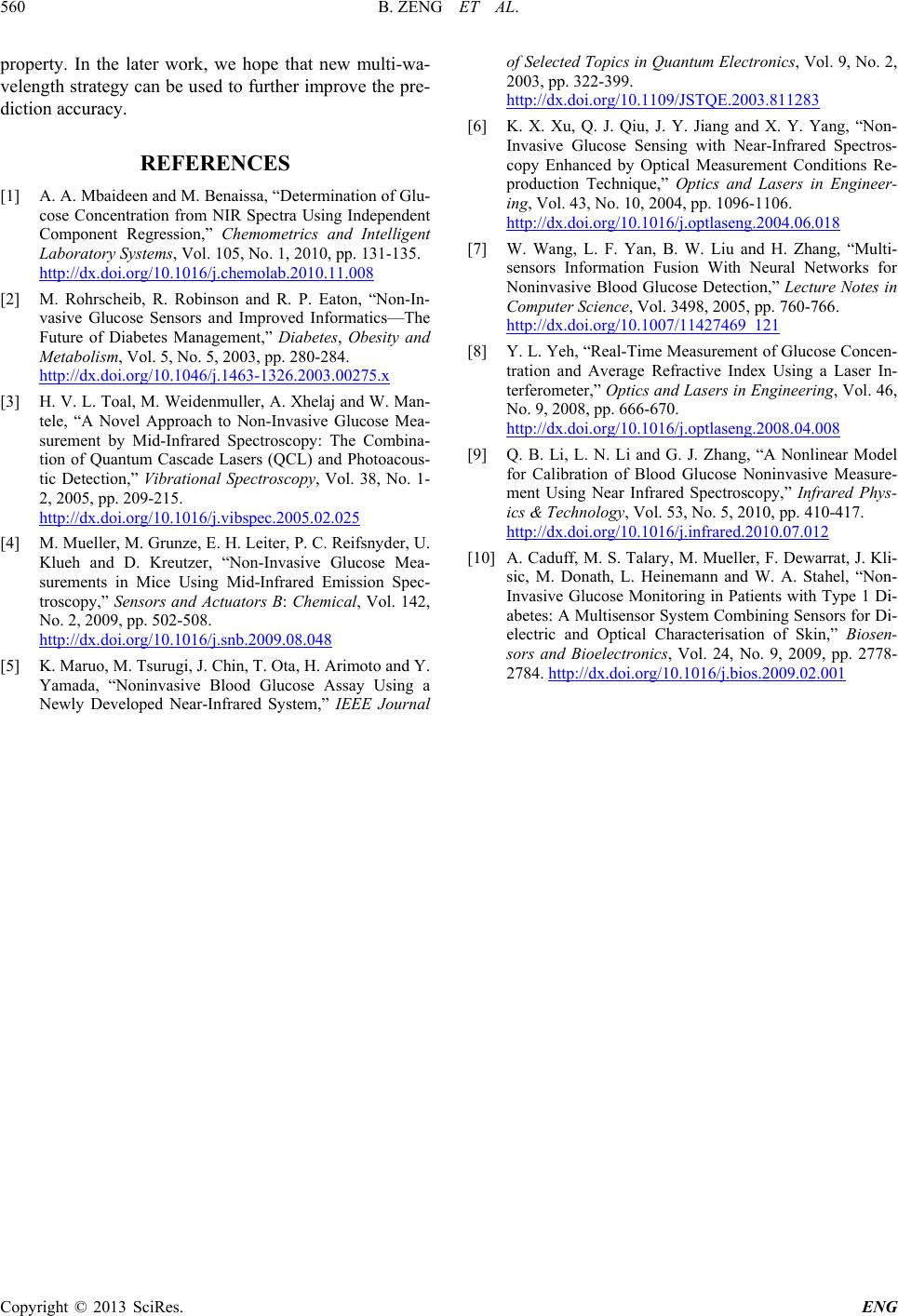
B. ZENG ET AL.
Copyright © 2013 SciRes. ENG
property. In the later work, we hope that new multi-wa-
velength stra tegy can be used to further improve th e pre-
diction accuracy.
REFERENCES
[1] A. A. Mbaideen and M. Benaissa, “Determination of Glu-
cose Concentration from NIR Spectra Using Independent
Component Regression,” Chemometrics and Intelligent
Laboratory Systems, Vol. 105, No. 1, 2010, pp. 131-135.
http://dx.doi.org/10.1016/j.chemolab.2010.11.008
[2] M. Rohrscheib, R. Robinson and R. P. Eaton, “Non-In-
vasive Glucose Sensors and Improved Informatics—The
Future of Diabetes Management,” Diabetes, Obesity and
Metabolism, Vol. 5, No. 5, 2003, pp. 280-284.
http://dx.doi.org/10.1046/j.1463-1326.2003.00275.x
[3] H. V. L. Toal, M. Weidenmuller, A. Xhelaj and W. Man-
tele, “A Novel Approach to Non-Invasive Glucose Mea-
surement by Mid-Infrared Spectroscopy: The Combina-
tion of Quantum Cascade Lasers (QCL) and Photoacous-
tic Detection,” Vibrational Spectroscopy, Vol. 38, No. 1-
2, 2005, pp. 209-215.
http://dx.doi.org/10.1016/j.vibspec.2005.02.025
[4] M. Mueller, M. Grunze, E. H. Leiter, P. C. Reifsnyder, U.
Klueh and D. Kreutzer, “Non-Invasive Glucose Mea-
surements in Mice Using Mid-Infrared Emission Spec-
troscopy,” Sensors and Actuators B: Chemical, Vol. 142,
No. 2, 2009, pp. 502-508.
http://dx.doi.org/10.1016/j.snb.2009.08.048
[5] K. Maruo, M. Tsurugi, J. Chin, T. Ota, H. Arimoto and Y.
Yamada, “Noninvasive Blood Glucose Assay Using a
Newly Developed Near-Infrared System,” IEEE Journal
of Selected Topics in Quantum Electronics, Vol. 9, No. 2,
2003, pp. 322-399.
http://dx.doi.org/10.1109/JSTQE.2003.811283
[6] K. X. Xu, Q. J. Qiu, J. Y. Jiang and X. Y. Yang, “Non-
Invasive Glucose Sensing with Near-Infrared Spectros-
copy Enhanced by Optical Measurement Conditions Re-
production Technique,” Optics and Lasers in Engineer-
ing, Vol. 43, No. 10, 2004, pp. 1096-1106.
http://dx.doi.org/10.1016/j.optlaseng.2004.06.018
[7] W. Wang, L. F. Yan, B. W. Liu and H. Zhang, “Multi-
sensors Information Fusion With Neural Networks for
Noninvasive Blood Glucose Detection,” Lecture Notes in
Computer Science, Vol. 3498, 2005, pp. 760-766.
http://dx.doi.org/10.1007/11427469_121
[8] Y. L. Yeh, “Real -Time Measurement of Glucose Concen-
tration and Average Refractive Index Using a Laser In-
terferometer,” Optics and Lasers in Engineering, Vol. 46,
No. 9, 2008, pp. 666-670.
http://dx.doi.org/10.1016/j.optlaseng.2008.04.008
[9] Q. B. Li, L. N. Li and G. J. Zhang, “A Nonlinear Model
for Calibration of Blood Glucose Noninvasive Measure-
ment Using Near Infrared Spectroscopy,” Infrared Phys-
ics & Technology, Vol. 53, No. 5, 2010, pp. 410-417.
http://dx.doi.org/10.1016/j.infrared.2010.07.012
[10] A. Caduff, M. S. Talary, M. Mueller, F. Dewarrat, J. Kli-
sic, M. Donath, L. Heinemann and W. A. Stahel, “Non-
Invasive Glucose Monitoring in Patients with Type 1 Di-
abetes: A Multisensor System Combining Sensors for Di-
electric and Optical Characterisation of Skin,” Biosen-
sors and Bioelectronics, Vol. 24, No. 9, 2009, pp. 2778-
2784. http://dx.doi.org/10.1016/j.bios.2009.02.001